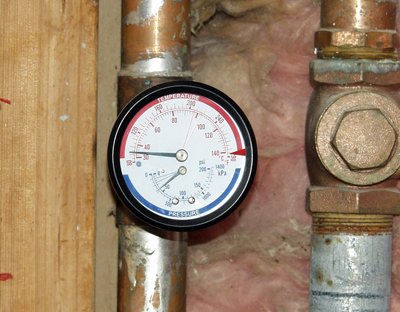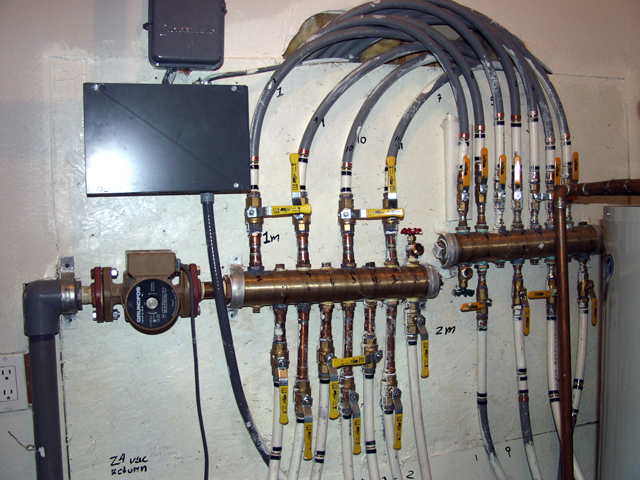|
|
Webster’s Dictionary defines hydronic as “being a system of heating or cooling that involves transfer of heat by a circulating fluid.” This is precisely how the hydronic heating system in the home works. 13,000 feet of special piping in the foundation carry hot water and heat the foundation. Each of the fourteen five ton AC units has traditional furnace heating as a backup.
The primary benefit of hydronic heating is “comfort”. The heating comes from the floor, not from the ceiling. Walking on toasty warm floors feels wonderful, particularly when compared to the hot dry air blown in your face by traditional heating. The hydronic heat is natural warmth coming from the floor as opposed to hot air, totally void of moisture, drying out you, your skin, your electronics and everything else. It is a pleasure to be able to go through the winter without getting shocked from static electricity. Although hydronic heating does not add moisture to the air, it does not remove it from the air as does traditional heating.
There are twenty five hydronic zones. Each zone is piped as a “home run” in that water comes direct from the hot water source to that zone and then is returned directly to the hot water heater for re-heating. In contrast would be a system piped “in series” where the hot water would go from one zone to the next so that the first zone in the series would receive the hottest water and the last zone in the series would have the coldest water due to the water having been cooled down by all of the rooms or zones ahead of it.
|
|
A large hot water heater supplies circulating water through the 13,000 feet of piping. The system is a closed circuit so the same water continually re-circulates.
The hydronic water heater is located in a garage closet. It sends water through the piping to three hydronic control centers located in the home. Each of control center has a distribution system to multiple zones. After water circulates through a given zone, the water is directly returned to the garage water heater.
|
|
In total, there are 25 zones which are identified as to which room (or in some cases part of a room) is serviced by that zone. Moving a valve handle from open to closed eliminates hydronic heating to that zone. If the valve handle is partially opened then partial heating is provided to that zone.
|
|
Anther benefit of hydronic heating is that the soil below the foundation is being heated just like the floors above the foundation. This helps prevent the sudden change in soil temperature which is so often the cause of soil movement and foundation problems.
|
|
Another of the benefits of hydronic heating is the ability to regulate each part of the home to its need and use. If a warmer or cooler temperature is needed for a specific room, just open or close the valve for that room.
|
|
.
|
|
 A gauge next to hydronic water heater shows the actual pressure running through the hydronic pipes as well as the temperature of the water being returned to the hydronic water heater. A valve next to the hot water heater can add or remove the amount of water running through the system which raises or lowers the pressure accordingly. |
The bronze manifolds below were re-cast and replaced because of sub standard material used for the original manifolds. The system has since been maintenance free.
 The bronze horizontal tubes are the manifolds. They receive the newly heated hot water, supply it to the zones connected to that manifold and then return the used water back to the hot water heater for re-heating. There are two additional areas similar to the above located elsewhere in the home. |
The hydronic system was designed with recognition of the possibility that that the foundation could move and cause a break in a hydronic pipe, even though the pipes are very flexible. Were such an event to occur, each zone has a valve to cutoff both the supply of water to the zone as well as a the return of water from the zone. Turning both valves off would have the effect of removing that particular zone from the entire system. The standard AC furnaces standby ready, willing and able to supply standard heating should the need arise.